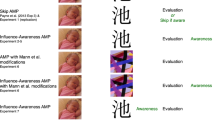Abstract
This experiment examined the mediating role of affective cues in persuasion. College students were exposed to advertisements that contained or did not contain affective cues in the form of humor, and that contained or did not contain information about the advertised product. As intended the affective cues were found to influence attitudes toward the advertisement (Aad), while the productrelevant information was found to influence attitudes toward the advertised product (Ab). By manipulating Aad and Ab independently, it was possible to test for the causal mediation of one attitude on the other. The results showed that Ab had a significant mediating (p<.05) effect on Aad, but that Aad did not significantly mediate Ab.
Similar content being viewed by others
References
Abelson, Robert P., Donald R. Kinder, Mark D. Peters, and Susan T. Fiske. (1982). “Affective and Semantic Components in Political Person Perception,”Journal of Personality and Social Psychology 42, 619–630.
Baron, Reuben M., and David A. Kenny. (1986). “The Moderator-Mediator Variable Distinction in Social Psychological Research: Conceptual, Strategic, and Statistical Considerations,”Journal of Personality and Social Psychology.
Holbrook, Morris B., and Rajeev Batra. (1987). “Assessing the Role of Emotions as Mediators of Consumer Responses to Advertising,”Journal of Consumer Research 14, 404–420.
MacKenzie, Scott B., Richard J. Lutz, and George E. Belch. (1986). “The Role of Attitude Toward the Ad as a Mediator of Advertising Effectiveness: A Test of Competing Explanations,”Journal of Marketing Research 23, 130–143.
Mitchell, Andrew A., and Jerry C. Olson. (1981). “Are Product Attribute Beliefs the Only Mediator of Advertising Effects on Brand Attitude?”Journal of Marketing Research 18 (2), 318–332.
Shimp, Terence A. (1981). “Attitude Toward the Ad as a Mediator of Consumer Brand Choice,”Journal of Advertising 10, 9–15.
Smith, Eliot R. (1982). “Beliefs, Attributions, and Evaluations: Nonheirarchical Models of Mediation in Social Cognition,”Journal of Personality and Social Psychology 43(2), 248–259.
Author information
Authors and Affiliations
Rights and permissions
About this article
Cite this article
Madden, T.J., Ajzen, I. Affective cues in persuasion: An assessment of causal mediation. Market Lett 2, 359–366 (1991). https://doi.org/10.1007/BF00664222
Issue Date:
DOI: https://doi.org/10.1007/BF00664222




